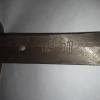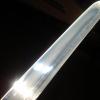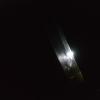i didnt know how to add pics to my original thread , so im creating this one specifically for picture uploading of my prized sword from my personal collection. |
|||
 |
Nihonto ClubJapanese Sword Information Exchange |
User login |
|
|
Disclaimer: Nihontō Club owners and independent contributors will not be held responsible for any loss, damage or inconvenience caused as a result of any inaccuracy or error within this website. Except where otherwise noted, this page is licensed under a Creative Commons License.
|





not old
Sorry, but I don't see anything that makes me think this is an old sword.
Some specific examples:
The chiseling of the signature is sharp and clear. Compare to what you see on an old signature - the expected rust rounds off the edges a bit. In a very old blade, it would be barely visible.
The mekugi-ana also appears to have sharp edges, like seen on 20th century (or newer) blades.
The tang looks new - filemarks and forging flaws are visible - no sign that it ever had a patina.
The tang is not a "proper" shape for a Japanese sword. It is very long, and not tapered, and the shinogi line is not straight.
From what I see of the tsuba, it is large, thick, and solid brass. Nothing that should be found on an old or quality blade.
No visible features of hamon or hada. Of course, these features become invisible if someone uses a buffing wheel to "clean" the blade (a lot of good blades have been ruined by folks that didn't know).
MY OPINION:
At best, it is a low-quality WWII GUNTOu with some strange features.
More likely, it is a Chinese fake. Unfortunately they are very common these days. When I first started collecting in the early 1980's, it wasn't a problem...
If you find an experienced collector that thinks otherwise, please post their views. I would be interested in their explanation.
You could also post pictures and questions on Nihonto Message Board - there are several very experienced collectors there also:
http://www.militaria.co.za/nmb/
Sorry to give you bad news. Hey, it's always possible that I'm wrong/confused... :-)
Pete
kanji note
BTW, you may not realize the following:
In your original post, you mentioned "Honjo Masamune", which is a famous sword that has been missing since WWII, and has the nickname "sword of power" (apparently).
You also posted a picture from a Markus Sesko article about Hanjo, the student of Hankei.
Your blade's signature is something-JO, the same "JO" as in "Hanjo", but it does not say either HANJO or HONJO (BTW, the kanji for Honjo as in "Honjo Masamune", are both completely different from what you have - the HON is the same as in NIHON).
But there is no connection between Hanjo (a swordsmith) and the "Honjo Masamune" (a particular sword by Masamune) - notice the difference in spelling.
Also note that the "Honjo Masamune" does not say "Honjo" in the signature - the "Honjo" is a nickname for that particular sword.
Pete
thanks for the post pete
i was under the impression that some of these swords have nick names and i was using markus seskos note as an example of how hanjo would be spelled in the 16th century being the same time frame as hanjo shigenaga, i know it is uncommon for smiths to actually sign the blades they made ,but i figured there may be a chance that the general signed the tang with his name . also the tang was definately reworked and extended and also there are signs of what was left from the previous gold inscriptions that appear to have been there originally. please if you could zoom in on the blade and have a look at the pattern of the nie . i have compared it side by side to the nie of masamune and it matches perfectly . it looks like patterns of the number 3,6,8, and also the nie gives off beautiful colors of light . if you could take the time and have a peek i would appreciate any feedback .as this sword and its maker and completely mystify me . thanks ;)
nie
>some of these swords have nick names
Only a handful of very famous and valuable blades have nicknames like this.
Of course, I may choose to name my sword "Frederick", but that doesn't count :-) .
>i know it is uncommon for smiths to actually sign the blades they made
Wrong. Many smiths signed their work. I don't know a percentage, but it's quite common. Go to a site of a dealer, and compare how many are signed, vs how many are "mumei" (unsigned). Browse around Ed Marshall's site at http://yakiba.com .
>but i figured there may be a chance that the general signed the tang with his name
Extremely unlikely. A Japanese person would never do this. It would be like me buying an expensive painting, then putting my own name in the corner... There are rare examples where the swordsmith will put the customer's name on a tang, such as "made for Joe, by Fred".
>zoom in on the blade and have a look at the pattern of the nie
I don't see anything that I would call "nie" in your pictures. For an actual example of nie, see the close-up pictures here, with Ed Marshall's excellent photography:
http://yakiba.com/Kat_Fuyihiro.htm
The nie is the "little gritty spots" close to the edge of the hamon. The more cloudy-looking stuff may be "nioi".
Without a good polish, nie and nioi are difficult/impossible to see at all. Your blade does NOT have a good polish, and I don't believe it's a Japanese polish at all.
>i have compared it side by side to the nie of masamune and it matches perfectly
That's not how it works. I think you're not understanding what nie really is. If you were a very high-level expert in Japanese swords, and you said "this looks like nie in the style of Masamune", then I would believe you. But I don't expect an expert to actually say that, because the presence/absence of nie is just one of many features that must be studied to make any comparison with Masamune (or any smith). Sorry...
I'm sure you would like to hear someone say "You have a super-awesome blade that was made 600 years ago by the single most famous smith (Masamune), and it's worth $500,000!". I'm sorry to be harsh, but I think it's likely a Chinese fake.
Pete
in regards to holograms on blade in the steel
is it a common feature for these blades to have portraits embedded in the steel of samurai ? and when the sword is moved back and forth under the light these portraits move around like a hologram . but when viewed normally it appears as though there is nothing there . the details are remarkable . i cant seem to find any other sword out there that has this feature . it is very strange and its not engraved ,its not acid etched . it is within the steel itself. is it possible that the chinese quality of blades has surpassed japanese quality considering that japanese swords are a evolved version of chinese blades . ? I just dont understand how these images are created and also when it is polished the images change to new ones , for some reason they are all portraits , thanks again Pete ,